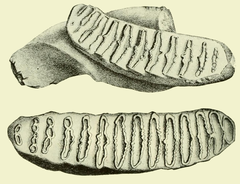Loxodonta atlantica
| Règne | Animalia |
|---|---|
| Embranchement | Chordata |
| Sous-embr. | Vertebrata |
| Classe | Mammalia |
| Ordre | Proboscidea |
| Famille | Elephantidae |
| Genre | Loxodonta |
Loxodonta atlantica est une espèce fossile d'éléphants d'Afrique du genre Loxodonta (qui comprend les éléphants d'Afrique vivants).
Description
[modifier | modifier le code]Loxodonta atlantica était plus grand que les éléphants d'Afrique modernes, avec une dentition plus progressive[1]. Il comprend des fossiles du Pléistocène de Ternifine, en Algérie[2], des fossiles du Pléistocène moyen d'Elandsfontein, en Afrique du Sud et des fossiles du Pliocène supérieur de la rivière Omo, en Éthiopie[3].
Il est suggéré d'avoir une date d'extinction d'environ 400 000 ans, au Pléistocène moyen[4]. Il a été suggéré que L. atlantica dérive probablement de L. adaurora[5] ; ou L. exoptata[6].
C'est probablement un ancêtre de l'éléphant de savane d'Afrique actuel, Loxodonta africana[6], avec lequel il a coexisté au Pléistocène moyen avant son extinction[3].
Liste de sous-espèces
[modifier | modifier le code]- †Loxodonta atlantica atlantica (Pomel, 1879) - Afrique du Nord[5]
- †Loxodonta atlantica zulu (Scott, 1907) - Afrique australe[5]
Classification
[modifier | modifier le code]Le nom valide complet (avec auteur) de ce taxon est Loxodonta atlantica (Pomel, 1879)[7].
Le type de Loxodonta atlantica est conservé au Muséum national d'histoire naturelle de Paris, mais est répertorié sans numéro de spécimen[6].
L'espèce a été initialement classée dans le genre Elephas sous le protonyme Elephas atlanticus Pomel, 1879[7],[8].
Loxodonta atlantica a pour synonyme[7] :
- †Elephas atlanticus Pomel, 1879
- †Palaeoloxodon atlanticus (Pomel, 1879)
Étymologie
[modifier | modifier le code]L'épithète spécifique, du latin atlantica, « de l'Atlas », a été donnée en référence « aux premiers hommes mentionnés dans la mythologie dans le massif du Nord de l'Afrique »[8].
Publication originale
[modifier | modifier le code]- A. Pomel, « Ossements d'Éléphants et d'Hippopotames découverts dans une station préhistorique de la plaine d'Eghis (province d'Oran) », Bulletin de la Société géologique de France, Paris, Inconnu et EDP Sciences, vol. 7, , p. 44-51 (ISSN 0037-9409 et 1777-5817, OCLC 1765827, lire en ligne).
Liens externes
[modifier | modifier le code]- (en) Taxonomicon : †Loxodonta atlantica (Pomel, 1879) (consulté le )
- (en) Paleobiology Database : †Loxodonta atlantica (Pomel, 1879) (consulté le )
Notes et références
[modifier | modifier le code]- ↑ R. Norman Owen-Smith, Megaherbivores: the influence of very large body size on ecology, Cambridge University Press, (ISBN 0-521-36020-X)
- ↑ D. Geraads, « Dating the Northern African cercopithecid fossil record », Human Evolution, vol. 2, , p. 19–27 (DOI 10.1007/BF02436528, S2CID 84223113, lire en ligne)
- Jane Carruthers, André Boshoff, Rob Slotow, Harry C. Biggs, Graham Avery et Wayne Matthews, Elephant management: A Scientific Assessment for South Africa, Wits University Press, , 23–83 p. (ISBN 978-1-86814-479-2, DOI 10.18772/22008034792), « The Elephant in South Africa: History and Distribution »
- ↑ (en) Mathew Stewart, Julien Louys, Gilbert J. Price, Nick A. Drake, Huw S. Groucutt et Michael D. Petraglia, « Middle and Late Pleistocene mammal fossils of Arabia and surrounding regions: Implications for biogeography and hominin dispersals », Quaternary International, vol. 515, , p. 12–29 (DOI 10.1016/j.quaint.2017.11.052, lire en ligne)
- Y. Coppens, V. J. Maglio, C. T. Madden et M. Beden, Evolution of African mammals, Cambridge MA, Harvard University Press, , 336–367 p. (ISBN 0-674-27075-4), « Proboscidea »
- Nancy E. Todd, « New Phylogenetic Analysis of the Family Elephantidae Based on Cranial‐Dental Morphology », The Anatomical Record: Advances in Integrative Anatomy and Evolutionary Biology, vol. 293, no 1, , p. 74–90 (PMID 19937636, DOI 10.1002/ar.21010
 )
)
- Fossilworks Paleobiology Database, consulté le 2 mai 2024.
- Pomel 1879, p. 99
